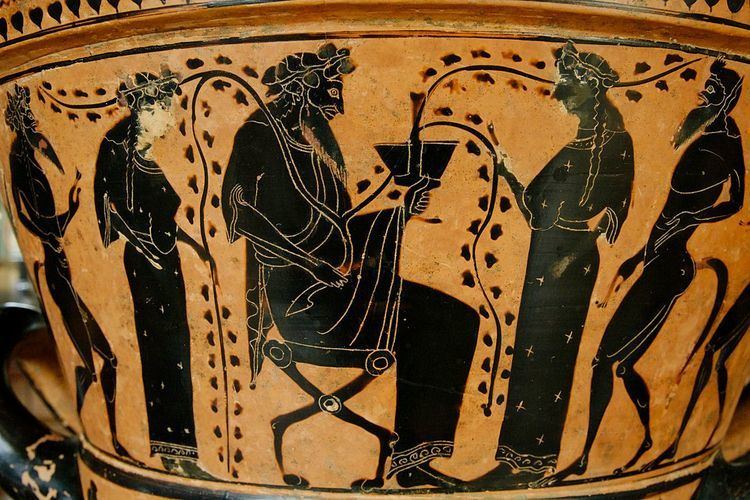 | ||
In Greek mythology and religion, the thiasus (Greek thiasos), was the ecstatic retinue of Dionysus, often pictured as inebriated revelers. Many of the myths of Dionysus are connected with his arrival in the form of a procession. The grandest such version was his triumphant return from "India", which influenced symbolic conceptions of the Roman triumph and was narrated in rapturous detail in Nonnus' Dionysiaca. In this procession, Dionysus rides a chariot, often drawn by big cats such as tigers, leopards, or lions.
Contents
The thiasos of the sea god Poseidon is depicted as a triumphal wedding procession with Amphitrite, attended by figures such as sea nymphs and hippocamps.
In historical Greek society, thiasoi (plural) were religious organizations whose existence was protected by law.
Dionysian thiasos
The most significant members of the thiasus were the human female devotees, the maenads, who gradually replaced immortal nymphs. In Greek vase-paintings or bas-reliefs, lone female figures can be recognized as belonging to the thiasus by their brandishing the thyrsos, the distinctive staff or rod of the devotee.
Other regulars of the retinue were various nature spirits, including the sileni (or human dancers costumed as such), phalluses much in evidence, satyrs, and Pan. The ithyphallic sileni are often shown dancing on vase paintings. The tutor of Dionysus is represented by a single aged Silenus. The retinue is sometimes shown being brought before a seated recipient: the tragic human welcomer of the gift of wine, Ikarios or Semachos, and his daughter, Erigone. In the triumphal form of procession, Ariadne sometimes rides with Dionysus as his consort. Heracles followed the thiasus for a short while following his loss of a drinking contest to Dionysus.
On the 6th-century BC François Vase, Dionysus is accompanied in procession by the three Horae. Other notable depictions in art include the silver "Great Dish" from the Mildenhall Treasure, the Lycurgus Cup, and in the Renaissance Titian's Bacchus and Ariadne. The Dionysian retinue was a popular subject for Roman art, especially bas-reliefs and sarcophagus panels.
Thiasos of the sea
The marine or sea thiasos depicted Poseidon and his retinue. An original work of Skopas on this theme was taken to Rome and lost, but the scene is well represented in Roman art, from tiny decorative reliefs and large sarcophagus panels to extensive mosaics.
